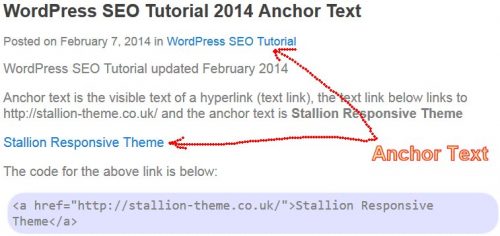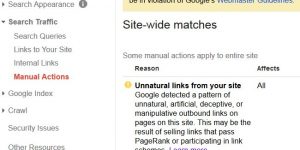The anchor text of a text link is very important for good search engine rankings, but most webmasters building links to a page tend to be obsessed with the anchor text of incoming links (links to a page from external domains) and practically forget about the anchor text of internal links they have full control over: internal/external Google doesn’t really distinguish between them, they are all links.
Before we discuss more advanced anchor text SEO strategies if you aren’t familiar with anchor text, see the WordPress SEO anchor text tutorial that explains what anchor text is with HTML examples.
Links FROM a page are also very important to it’s search engine rankings, if you want a Search Engine Results Page (SERP) like “Anchor Text Optimization” the best web pages you can link TO from the page you are targeting at the “Anchor Text Optimization” SERP are other pages targeting the same AND similar related SERPs: note the link above, it’s anchor text includes part of this pages main SERP (anchor text).
Basically when you create an article link FROM it to related webpages with relevant keyword rich anchor text.
Internal Links Anchor Text Optimization
What we are discussing here is how to make the most of the link juice your site has generated from backlinks (on-site SEO).
Example: this page is targeted at anchor text related keyword phrases, main keyword phrases Anchor Text Optimization and it’s semantic derivatives. Since it’s a new article (April 2014) it has no incoming links from external web pages, all the links to this page will be generated from internal links, anchor text from the recent posts widget and the How to Search Engine Optimization WordPress category.
Yet a few days from now it could be ranked high for relevant Google SERPs, HOW?
A lot of SERPs are based almost entirely on a combination of internal links anchor text and of course the pages content: can’t expect to rank for a keyword phrase without the phrase being used in the content. AKA all on-site SEO which you as a webmaster have full control over.
I use an advanced Hummingbird SEO feature that’s built into the WordPress SEO theme I develop that rather than WordPress widgets and categories use just the one version of anchor text for links to a page (title of a WordPress post), they use a set of semantically related keyword phrases instead.
The automated links (those generated by the theme and WordPress) use these 6 keyword phrases for internal anchor text (I’ve set them under this articles Edit Post screen, see the WordPress SEO Posts Widget article for a lot more detail):
Link Anchor Text Optimization (this is the WordPress title of the post)
Anchor Text Optimization (this is the title tag for the post)
Anchor Text SEO
Link Anchor Text SEO
Anchor Text Link SEO
Anchor Text
Since I named this article “Link Anchor Text Optimization” if I used another WordPress theme at best all theme/WordPress automatically generated internal links to this article would use the anchor text “Link Anchor Text Optimization”.
I say at best because some WordPress themes are terrible SEO wise and will use anchor text like “Click Here” or “Continue Reading”!!!! If you have a basic SEO optimized WordPress theme the least you should expect is all internal links use optimized anchor text.
Link Anchor Text SEO
If you look through this site, view various posts, categories, home page etc… you would find those 6 keyword phrases are used by various parts of the site as anchor text for links to here.
For example if someone comments on this article there will be a link from the Recent Comments Widget that on the home page will use anchor text “Link Anchor Text SEO“, same Recent Comments widget, but on blog posts the anchor text is “Anchor Text“, for static Pages it’s “Anchor Text Optimization“, for categories it’s “Link Anchor Text Optimization“.
Each section of the site loads a different keyword phrase (from the list above) as anchor text for that widget: this is an advanced WordPress SEO theme feature. For the other widgets Recent Posts and Popular Posts the same phrases are used, but in a different order, where the Recent Comments Widget on the home page used “Link Anchor Text SEO” the Popular Posts Widget would use “Anchor Text Optimization” and the Recent Posts Widget would use “Anchor Text Link SEO“.
The above is very important for post Google Panda/Penguin SEO, Google has been looking more closely at how natural the anchor text of links appear with their latest web search algorithm (Hummingbird) taking this to a new level by looking for question like search phrases into account.
Contextual Links Anchor Text
Since most webmasters reading this will not use my WordPress theme, it’s HARD to achieve the same level of SEO I can achieve without a lot of effort (even what I do takes a lot of time), you can still benefit from this approach by internally linking to your articles with varied anchor text. Currently there’s two more articles on this site that specifically target anchor text derivative SERPs, have an article about an anchor text SEO test and the WordPress SEO anchor text optimization article. After publishing this article I’ll go edit those articles to see if I can add a relevant link to this article.
There are also many other articles on this site that refer to anchor text, as I maintain the site I’ll try to add links from those to here as well. You should do this with all new articles, look through your site for relevant articles to link from and to. As you read this article you’ll have seen around half a dozen contextual links (links from the content) that I added manually, some are about anchor text, others about related subjects, it all helps SEO wise.
5+ years ago best SEO anchor text practice was if you wanted a SERP like “Anchor Text Optimization” you’d create a post targeting the SERP (like this page) and try to gain as many backlinks as possible (internal and external) using the exact phrase “Anchor Text Optimization” as the anchor text (really easy to achieve).
We didn’t generally target semantic derivatives of a SERP because Google saw “Anchor Text Optimization” and “Anchor Text Optimized” or even “Anchor Text Optimisation” (note the UK spelling of Optimisation with an s) as not really the same SERP (ideally you’d target another article at the other SERPs).
2014+ SEO is different, Google ‘sees’ the above three phrases as semantic derivatives, (not the same, but similar/related) it will show web pages optimized for any of the above phrases for all three Google searches. Makes our job both easier and harder, we can create less articles to target more SERPs, but we have to consider how Google works.
In 2014 avoid ONLY linking with the perfect SEO anchor text, you will see from my contextual links above some of the anchor text is far from SEO perfect (I wouldn’t have done this 5 years ago). Some SEO’s think there’s an over optimization anchor text penalty, I don’t think this is the case per se. A Google anchor text penalty is not the same as not the best way to persuade Google to rank a page high :-) It’s not a Google penalty, you haven’t supplied Google what it wants.
If Google finds almost all your links (incoming and internal) are using pretty much identical anchor text (like SEO’s aimed for 5+ years ago) it suggests the links aren’t all natural links. No one knows precisely how Google measures how to pass anchor text benefit today, I’m working on the assumption that the more varied you can make your anchor text without going anti-SEO (don’t use “Click Here”) more likely Google won’t have a reason to NOT rank your web pages for the keyphrases you are targeting.
If a page has 500 backlinks and overall there are 100 different phrases used for the anchor text, that strongly suggests the links are natural. On the other hand 20,000 backlinks and they only use 3 phrases, strongly suggests there’s some unnatural linking occurring, real people don’t always use the perfect SEO anchor text while SEO experts generating backlinks try to.
David Law




Anchor Text of Outbound Links
Links from a page are very important to it’s rankings, if you want a SERP like Search Engine Rankings the best web pages you can link to from the page that targets this SERP should be about Search Engine Rankings and the anchor text should include the SERP or similar derivative. A derivative phrase might be “Google Rankings” or “Top 10 Search Engine Rankings” all that matters is some of the anchor text uses some/all of the same words as the main SERPs.
So you’d ideally link to the top resources on the subject matter using relevant keyword rich anchor text. Those resources can be on external sites or on the same site, both help.
Now if you add a lot of unrelated links from a page (the anchor text isn’t relevant) you water down the optimization of the outbound links anchor text, you are telling search engines like Google, Yahoo and MSN etc… that this page is also about these unrelated subjects and this means your important SERPs won’t receive maximum benefit from related outbound links anchor text.
This isn’t a penalty, more of you not taking full advantage of the fact anchor text of outbound links is important.
A general rule of thumb should be avoid too many unrelated links from a page or at least balance them with more related links, so the main SERPs story from the outbound anchor text reads main SERP not SERPs lucky dip :-)
I try to keep the number of unrelated links to below 5, but there are always exceptions.
Anchor Text of Outbound Links